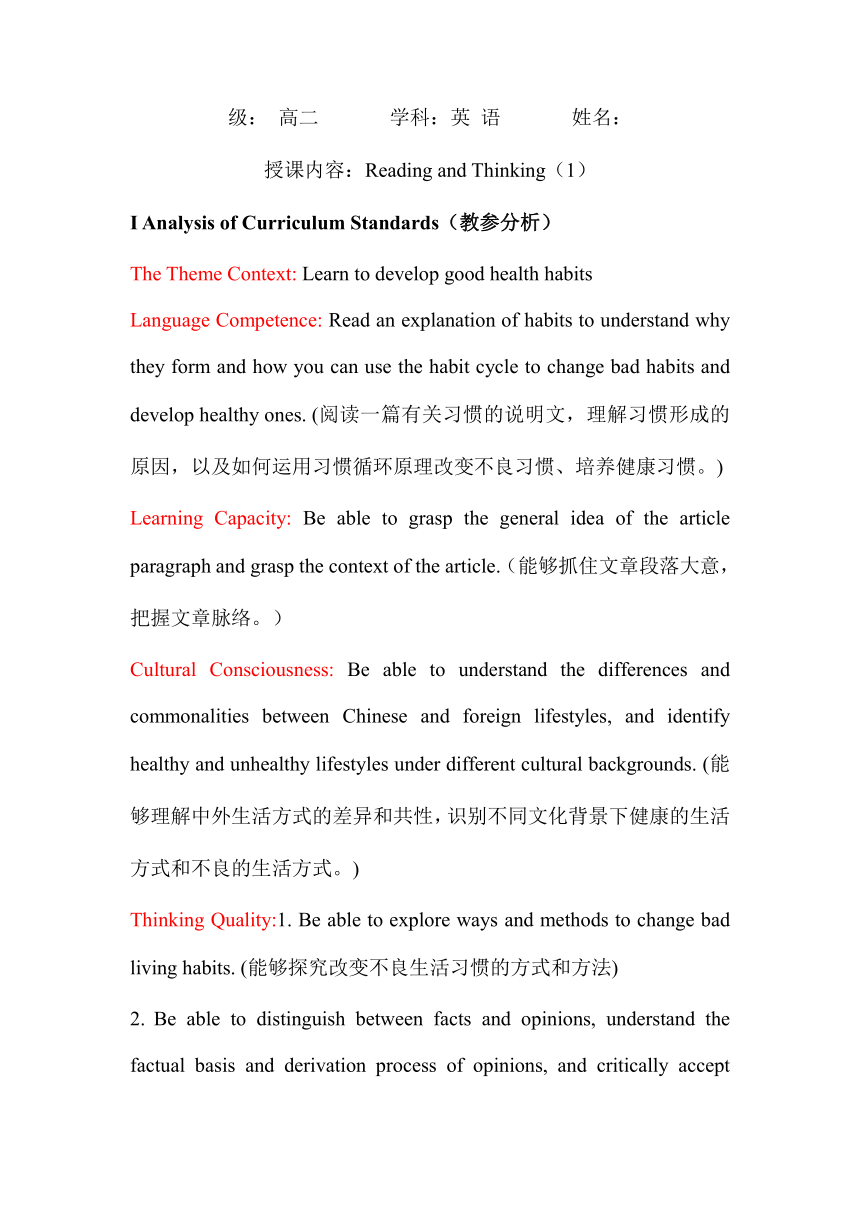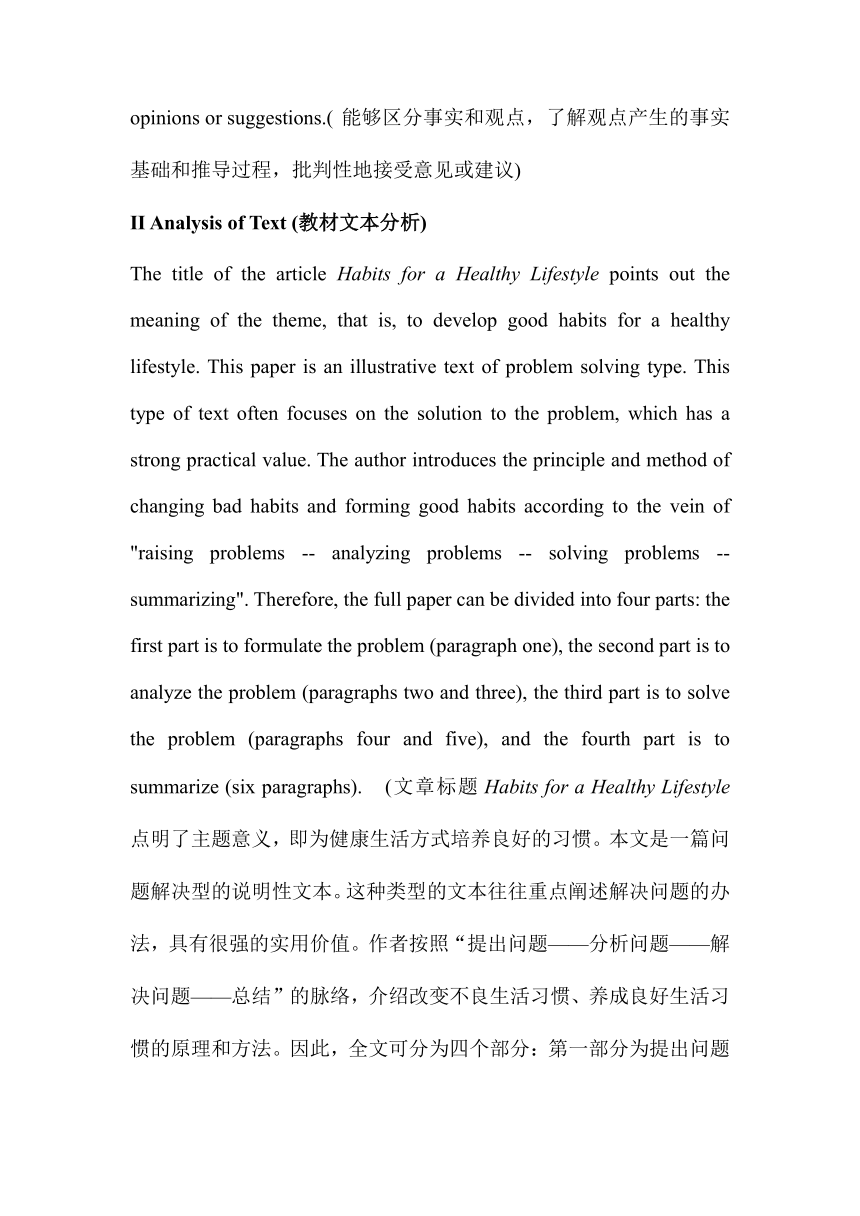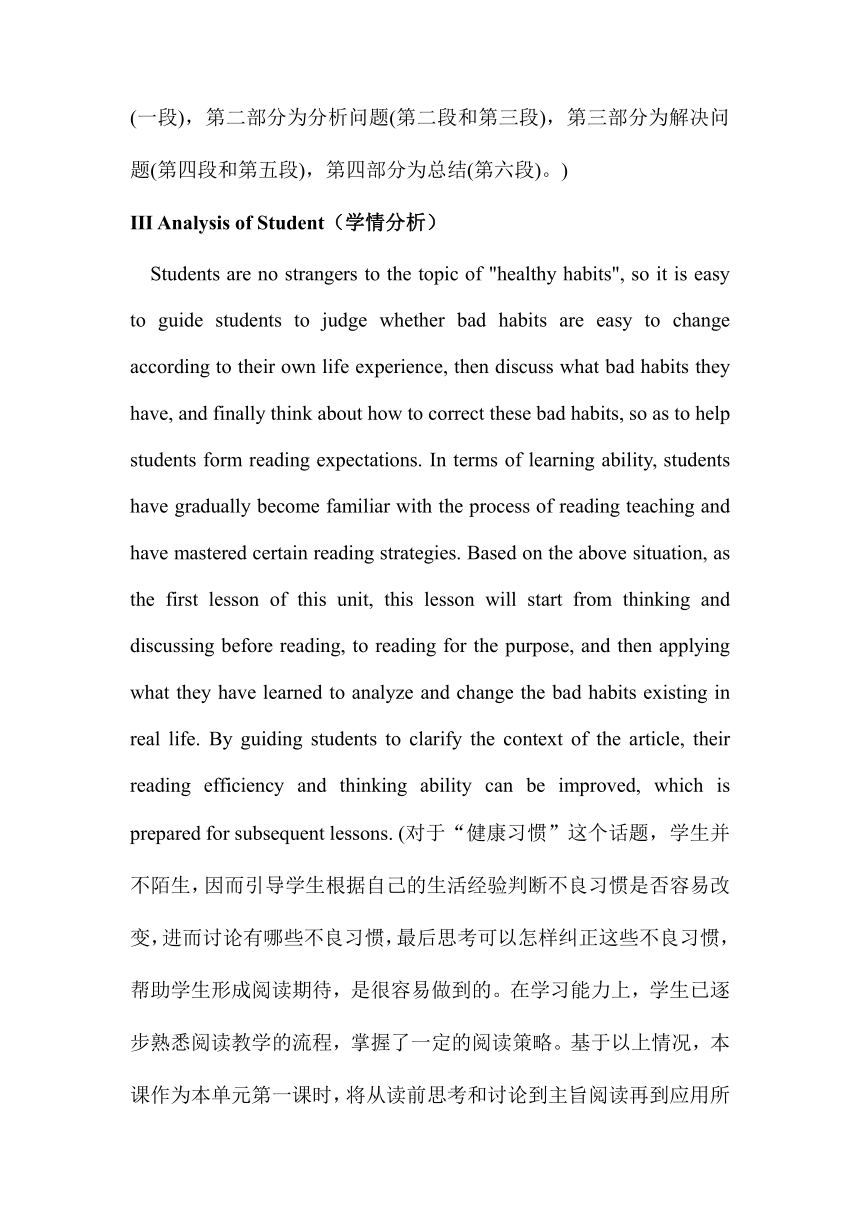人教版(2019) 选择性必修第三册 Unit 2 Healthy Lifestyle Reading & Thinking教案
文档属性
| 名称 | 人教版(2019) 选择性必修第三册 Unit 2 Healthy Lifestyle Reading & Thinking教案 |  | |
| 格式 | docx | ||
| 文件大小 | 26.4KB | ||
| 资源类型 | 教案 | ||
| 版本资源 | 人教版(2019) | ||
| 科目 | 英语 | ||
| 更新时间 | 2022-11-01 10:51:53 | ||
图片预览



文档简介
级: 高二 学科:英 语 姓名:
授课内容:Reading and Thinking(1)
Ⅰ Analysis of Curriculum Standards(教参分析)
The Theme Context: Learn to develop good health habits
Language Competence: Read an explanation of habits to understand why they form and how you can use the habit cycle to change bad habits and develop healthy ones. (阅读一篇有关习惯的说明文,理解习惯形成的原因,以及如何运用习惯循环原理改变不良习惯、培养健康习惯。)
Learning Capacity: Be able to grasp the general idea of the article paragraph and grasp the context of the article.(能够抓住文章段落大意,把握文章脉络。)
Cultural Consciousness: Be able to understand the differences and commonalities between Chinese and foreign lifestyles, and identify healthy and unhealthy lifestyles under different cultural backgrounds. (能够理解中外生活方式的差异和共性,识别不同文化背景下健康的生活方式和不良的生活方式。)
Thinking Quality:1. Be able to explore ways and methods to change bad living habits. (能够探究改变不良生活习惯的方式和方法)
2. Be able to distinguish between facts and opinions, understand the factual basis and derivation process of opinions, and critically accept opinions or suggestions.( 能够区分事实和观点,了解观点产生的事实基础和推导过程,批判性地接受意见或建议)
Ⅱ Analysis of Text (教材文本分析)
The title of the article Habits for a Healthy Lifestyle points out the meaning of the theme, that is, to develop good habits for a healthy lifestyle. This paper is an illustrative text of problem solving type. This type of text often focuses on the solution to the problem, which has a strong practical value. The author introduces the principle and method of changing bad habits and forming good habits according to the vein of "raising problems -- analyzing problems -- solving problems -- summarizing". Therefore, the full paper can be divided into four parts: the first part is to formulate the problem (paragraph one), the second part is to analyze the problem (paragraphs two and three), the third part is to solve the problem (paragraphs four and five), and the fourth part is to summarize (six paragraphs). (文章标题Habits for a Healthy Lifestyle点明了主题意义,即为健康生活方式培养良好的习惯。本文是一篇问题解决型的说明性文本。这种类型的文本往往重点阐述解决问题的办法,具有很强的实用价值。作者按照“提出问题——分析问题——解决问题——总结”的脉络,介绍改变不良生活习惯、养成良好生活习惯的原理和方法。因此,全文可分为四个部分:第一部分为提出问题(一段),第二部分为分析问题(第二段和第三段),第三部分为解决问题(第四段和第五段),第四部分为总结(第六段)。)
Ⅲ Analysis of Student(学情分析)
Students are no strangers to the topic of "healthy habits", so it is easy to guide students to judge whether bad habits are easy to change according to their own life experience, then discuss what bad habits they have, and finally think about how to correct these bad habits, so as to help students form reading expectations. In terms of learning ability, students have gradually become familiar with the process of reading teaching and have mastered certain reading strategies. Based on the above situation, as the first lesson of this unit, this lesson will start from thinking and discussing before reading, to reading for the purpose, and then applying what they have learned to analyze and change the bad habits existing in real life. By guiding students to clarify the context of the article, their reading efficiency and thinking ability can be improved, which is prepared for subsequent lessons. (对于“健康习惯”这个话题,学生并不陌生,因而引导学生根据自己的生活经验判断不良习惯是否容易改变,进而讨论有哪些不良习惯,最后思考可以怎样纠正这些不良习惯,帮助学生形成阅读期待,是很容易做到的。在学习能力上,学生已逐步熟悉阅读教学的流程,掌握了一定的阅读策略。基于以上情况,本课作为本单元第一课时,将从读前思考和讨论到主旨阅读再到应用所学分析和改变现实生活中存在的不良习惯,从而引导学生厘清文章脉络,提升阅读效率的同时加入对思维能力的提升,为后续课时做准备。)
Ⅳ Learning Objectives(学习目标)
At the end of this lesson, students will be able to:
1. Able to grasp the general idea of each paragraph and grasp the context of the article.
2. Analyze the information and ideas in the paragraph, and summarize the formation and operation principle of the habit.
3. Analyze and change the bad habits in real life by using the habit cycle principle learned.
(在本课学习结束时,学生能够:
1. 能够抓住文章段落大意,把握文章脉络。
2. 分析段落信息和观点,概括总结习惯的形成和运作原理。
3.运用所学的习惯循环原理分析、改变现实生活中存在的不良习惯。)
Ⅴ Key & Difficult Points
1. Guide students to master the structural features of the problem-solving explanation text, and strengthen students’ ability to summarize the general idea of the paragraph;
2. Guide students to understand the formation and operation of habits, and use it to change bad habits and develop good habits.
(1.引导学生掌握问题解决型说明文本的结构特征,强化学生概括段落大意的能力;
2.引导学生了解习惯的形成以及运作原理,并运用它来改变坏习惯、养成好习惯。)
Ⅵ Teaching Procedure
Lead-in (读前思考和讨论,帮助学生形成阅读期待)
Discuss following questions.
(1) What habits do you think are unhealthy
(2) Have you ever tried to correct one bad habit How What was the result
Pre-Reading (阅读策略提示,为后续阅读做准备)
Guide students to browse the indicators and options of Activity 2, pay attention to the keywords in the options, and pre-select the answers.
Browse the policy prompt and prepare to read(引导学生浏览活动2 的指示语和选项,关注选项中的关键词,预选答案。
浏览策略提示框,准备阅读)
While-Reading(归纳段落大意,分析文章结构)
step 1 Read the text and check the answer to Activity 2. (可讨论,请学生具体说出匹配依据)
step 2 Analyze the text structure
(1) Answer following questions.
Why bad teenage habits should be changed?(Q)
What a habit is (Q)
The cycle of how habits are formed (Q)
How to change a bad habit and create good ones (Q)
Changing habits gradually
No easy way to change bad habits.
(2) Text Structure
The text can be divided into three parts.
Para 1: Why bad teenage habits should be changed
Para 2-5: What a habit is and how to change bad habits
Para 6: No easy way to change bad habits
(3) Pay attention to details
What should we do to change a bad habit Give an example by filling in the following table.
The habit cycle bad habit new habit
cue feel unhappy
Routine
Reward feel happier but it’s not healthy
After-Reading(应用所学改变坏习惯)
Think of one bad habit and write down the cue, routine and reward. Then come up with an idea of how to break the bad habit.
The habit cycle bad habit new habit
cue Finished lunch finish lunch
Routine Went back to the class and went to bed immediately Go to the playground and walk for 10 minutes
Reward feel relaxed but worried about its bad effect on health feel relaxed and healthier
授课内容:Reading and Thinking(1)
Ⅰ Analysis of Curriculum Standards(教参分析)
The Theme Context: Learn to develop good health habits
Language Competence: Read an explanation of habits to understand why they form and how you can use the habit cycle to change bad habits and develop healthy ones. (阅读一篇有关习惯的说明文,理解习惯形成的原因,以及如何运用习惯循环原理改变不良习惯、培养健康习惯。)
Learning Capacity: Be able to grasp the general idea of the article paragraph and grasp the context of the article.(能够抓住文章段落大意,把握文章脉络。)
Cultural Consciousness: Be able to understand the differences and commonalities between Chinese and foreign lifestyles, and identify healthy and unhealthy lifestyles under different cultural backgrounds. (能够理解中外生活方式的差异和共性,识别不同文化背景下健康的生活方式和不良的生活方式。)
Thinking Quality:1. Be able to explore ways and methods to change bad living habits. (能够探究改变不良生活习惯的方式和方法)
2. Be able to distinguish between facts and opinions, understand the factual basis and derivation process of opinions, and critically accept opinions or suggestions.( 能够区分事实和观点,了解观点产生的事实基础和推导过程,批判性地接受意见或建议)
Ⅱ Analysis of Text (教材文本分析)
The title of the article Habits for a Healthy Lifestyle points out the meaning of the theme, that is, to develop good habits for a healthy lifestyle. This paper is an illustrative text of problem solving type. This type of text often focuses on the solution to the problem, which has a strong practical value. The author introduces the principle and method of changing bad habits and forming good habits according to the vein of "raising problems -- analyzing problems -- solving problems -- summarizing". Therefore, the full paper can be divided into four parts: the first part is to formulate the problem (paragraph one), the second part is to analyze the problem (paragraphs two and three), the third part is to solve the problem (paragraphs four and five), and the fourth part is to summarize (six paragraphs). (文章标题Habits for a Healthy Lifestyle点明了主题意义,即为健康生活方式培养良好的习惯。本文是一篇问题解决型的说明性文本。这种类型的文本往往重点阐述解决问题的办法,具有很强的实用价值。作者按照“提出问题——分析问题——解决问题——总结”的脉络,介绍改变不良生活习惯、养成良好生活习惯的原理和方法。因此,全文可分为四个部分:第一部分为提出问题(一段),第二部分为分析问题(第二段和第三段),第三部分为解决问题(第四段和第五段),第四部分为总结(第六段)。)
Ⅲ Analysis of Student(学情分析)
Students are no strangers to the topic of "healthy habits", so it is easy to guide students to judge whether bad habits are easy to change according to their own life experience, then discuss what bad habits they have, and finally think about how to correct these bad habits, so as to help students form reading expectations. In terms of learning ability, students have gradually become familiar with the process of reading teaching and have mastered certain reading strategies. Based on the above situation, as the first lesson of this unit, this lesson will start from thinking and discussing before reading, to reading for the purpose, and then applying what they have learned to analyze and change the bad habits existing in real life. By guiding students to clarify the context of the article, their reading efficiency and thinking ability can be improved, which is prepared for subsequent lessons. (对于“健康习惯”这个话题,学生并不陌生,因而引导学生根据自己的生活经验判断不良习惯是否容易改变,进而讨论有哪些不良习惯,最后思考可以怎样纠正这些不良习惯,帮助学生形成阅读期待,是很容易做到的。在学习能力上,学生已逐步熟悉阅读教学的流程,掌握了一定的阅读策略。基于以上情况,本课作为本单元第一课时,将从读前思考和讨论到主旨阅读再到应用所学分析和改变现实生活中存在的不良习惯,从而引导学生厘清文章脉络,提升阅读效率的同时加入对思维能力的提升,为后续课时做准备。)
Ⅳ Learning Objectives(学习目标)
At the end of this lesson, students will be able to:
1. Able to grasp the general idea of each paragraph and grasp the context of the article.
2. Analyze the information and ideas in the paragraph, and summarize the formation and operation principle of the habit.
3. Analyze and change the bad habits in real life by using the habit cycle principle learned.
(在本课学习结束时,学生能够:
1. 能够抓住文章段落大意,把握文章脉络。
2. 分析段落信息和观点,概括总结习惯的形成和运作原理。
3.运用所学的习惯循环原理分析、改变现实生活中存在的不良习惯。)
Ⅴ Key & Difficult Points
1. Guide students to master the structural features of the problem-solving explanation text, and strengthen students’ ability to summarize the general idea of the paragraph;
2. Guide students to understand the formation and operation of habits, and use it to change bad habits and develop good habits.
(1.引导学生掌握问题解决型说明文本的结构特征,强化学生概括段落大意的能力;
2.引导学生了解习惯的形成以及运作原理,并运用它来改变坏习惯、养成好习惯。)
Ⅵ Teaching Procedure
Lead-in (读前思考和讨论,帮助学生形成阅读期待)
Discuss following questions.
(1) What habits do you think are unhealthy
(2) Have you ever tried to correct one bad habit How What was the result
Pre-Reading (阅读策略提示,为后续阅读做准备)
Guide students to browse the indicators and options of Activity 2, pay attention to the keywords in the options, and pre-select the answers.
Browse the policy prompt and prepare to read(引导学生浏览活动2 的指示语和选项,关注选项中的关键词,预选答案。
浏览策略提示框,准备阅读)
While-Reading(归纳段落大意,分析文章结构)
step 1 Read the text and check the answer to Activity 2. (可讨论,请学生具体说出匹配依据)
step 2 Analyze the text structure
(1) Answer following questions.
Why bad teenage habits should be changed?(Q)
What a habit is (Q)
The cycle of how habits are formed (Q)
How to change a bad habit and create good ones (Q)
Changing habits gradually
No easy way to change bad habits.
(2) Text Structure
The text can be divided into three parts.
Para 1: Why bad teenage habits should be changed
Para 2-5: What a habit is and how to change bad habits
Para 6: No easy way to change bad habits
(3) Pay attention to details
What should we do to change a bad habit Give an example by filling in the following table.
The habit cycle bad habit new habit
cue feel unhappy
Routine
Reward feel happier but it’s not healthy
After-Reading(应用所学改变坏习惯)
Think of one bad habit and write down the cue, routine and reward. Then come up with an idea of how to break the bad habit.
The habit cycle bad habit new habit
cue Finished lunch finish lunch
Routine Went back to the class and went to bed immediately Go to the playground and walk for 10 minutes
Reward feel relaxed but worried about its bad effect on health feel relaxed and healthier
